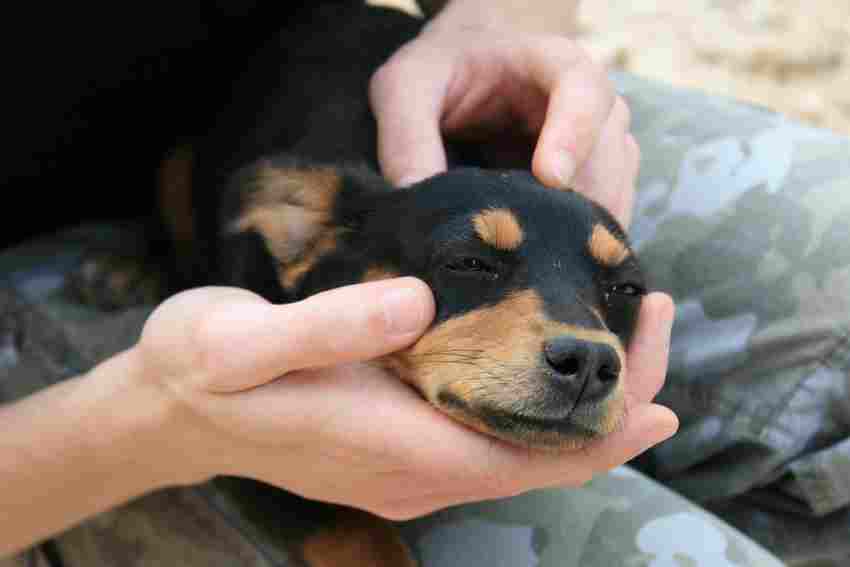There is no scientific study that shows for a fact that crate training can cause anxiety in a documented sample of dogs.
There are many assumptions about crate training causing dog anxiety, however, there are no facts backing these assumptions.
People have been crate training their dogs for a long time and they are happy with it. They’ve never complained about any anxious behavior what so ever.
I use a crate for all the dogs I had and still have and none of them have ever shown any symptoms of anxiety.
I am personally convinced that yes if the crate is not used properly and abused can, in fact, harm the dog. But used with moderation it can be a great tool for your dog’s mental stability.
When does crate training cause anxiety
Well as I mentioned before the crate is a great tool for home training dogs if used properly. If you lock your dog all day in his crate and don’t let him exercise and relax outside of the crate; He will most probably develop some sort of anxiety.
Dogs need to interact with humans and maybe other pets, they are very energetic animals that love the outdoors and playtime.
If you want your dog to be stable and healthy he needs to interact with you and other people. Or else he will be anxious around other pets and people, and that has nothing to do with the crate.
So the crate is not a direct cause of anxiety but could be a tool. It doesn’t matter if your dog is in a crate or a playpen or just locked in a room. If he does not have enough playtime and interaction it will lead to anxious behavior.
What causes dog anxiety?
So if crate training is not a direct cause of dog anxiety what are the causes?
There are surprisingly plenty of causes to dog anxiety, some could have nothing to do with us and some could be our fault.
Past trauma
Past trauma can cause dogs to suffer from severe anxious behavior. Dogs that have been abused or have been involved in traumatic incidents are more likely to develop anxieties.
Physical abuse has the most effect on dogs. They tend not to trust others and can be suspicious about everything.
Dogs that have been abandoned by prior owners can also develop anxieties and trust issues. So if you adopt a rescue dog you want to get any information you can have from the dog shelter so you can be prepared and know what to expect.
Medical issues
Any medical issue can cause dog anxieties, especially if it’s related to the nervous system.
Other medical issues like hearing can have a direct impact on the dog’s personality.
Fear
Fear is one of the most common causes of dog anxieties, sometimes a simple thunderstorm can make the dog very uncomfortable.
Dog crates should not be placed in areas whit loud machines or exposure to loud noises especially ones that dogs can’t locate their origin.
Loneliness
Dogs that are left alone and don’t have enough interaction with other humans or pets can develop severe anxieties.
They feel very uncomfortable around new people and other animals. This is generally the owner’s fault.
Your dog needs to have enough time outdoors to be around people and other pets.
Aging
Aging can be related to medical issues as the dog may experience hearing or movement trouble and starts feeling depressed.
This is usually a natural process that can be dealt with just with some more attention.
These are not the only causes of dog anxiety but, the most common ones. Some are related to the entourage of the dog and some are related to his overall health.
What are the symptoms of anxiety in dogs?
Dog anxiety has multiple symptoms, and some could easily be overlooked. Some symptoms are more obvious than others and whenever the dog is expressing some abnormal behavior you need to consult a specialist.
So what are the most common symptoms:
Depression
Depression is one of the most common symptoms of anxious dogs, it can be detected in the lack of energy and will to play and interact.
Depressed dogs will spend most of their time alone and react rarely to outside stimulations.
Aggression

Anxious dogs can be very aggressive even toward their guardians. They will be aggressive mostly around new people and other pets.
Aggression is never a normal behavior so whenever spotted in a dog a consult with a professional is advised.
Excessive salivation
Drooling and excessive salivation is often spotted among dogs that suffer from anxiety.
Some dogs do naturally salivate more than others but this will be unnatural and very excessive.
Destructive behavior
Anxious dogs especially those that suffer from separation anxiety are very destructive. They will chew on whatever they can put their mouths on.
This is never a normal behavior for dogs and it needs to be dealt with as soon as it appears and it’s quite an alarming symptom that the anxiety is very severe.
Excreting and Urinating around the house
If your dog is potty trained and just started all of a sudden urinating defecating around the house it’s a symptom.
Dogs don’t go back in potty training and are fairly clean animals so if you observe any changes other than occasional incidents you want to take action.
Exessive inexplicable barking
Dogs with anxieties usually bark for no apparent reason and can go on a relentless cycle.
This could be a sign of pain or medical issues also, so you want to make sure nothing else is bothering your dog.
Panting
If your dog has short breath with no apparent reason and no physical effort, it could be a sign of anxious behavior.
This is also very common in some other conditions so you want to closely observe your dog for other symptoms.
Does crate training help with anxiety
Crate training is clearly not the cause of anxiety but it is also not a cure for it.
Even if the crate training is done perfectly an anxious dog will still probably feel the same. Unless the anxiety is fear-related in which case a crate could be helpful as it provides a safe environment that helps calm the dog; crate training will probably not be very helpful.
One other aspect of crate training that I can see helpful is controlling the environment of an aggressive dog with destructive behavior.
A heavy-duty crate like this one can do a very good job confining your dog while you are not around ensuring he does not chew on something that could end up hurting him. In fact, this crate is chew-proof that’s why I would recommend it for anxious dogs especially stronger breeds.
Make no mistake an anxious dog can get hurt chewing on a regular crate even small dogs can.
How to crate train a dog that has anxiety
Crate training an anxious dog can be tough in fact it will be quite frustrating. The idea behind crate training is to make the dog relax and feel comfortable in his crate and if the dog is showing aggression or some compulsive behavior that’s going to be hard to motivate him.
All in all, if your dog is showing signs of anxiety of any type you want to consult a professional.
The only case of anxiety that I would recommend using crate training is fear-related anxieties. since the goal of the crate training is automatically dealing with it.
Other than that it is probably just going to make it worse, and your dog will probably not be very cooperative as you’d hope.
So again at first signs of anxiety you better seak treatment for your dog and avoid any stressful situations that can make things worse.
Why is my dog suddenly anxious?
In normal cases, anxiety is not sudden and does not just appear. It builds up over time due to multiple causes like we’ve exposed earlier.
So if there is a sudden change in your dog’s beghavior there is probably a trigger that you’ve missed.
Sudden anxiety in dogs
Dogs don’t analyze or rationalize situations they react; this implies that if your dog is suddenly anxious then there is a good reason for it.
In most cases sudden anxiety is fear-related, it could be as simple as a loud sound. Sometimes small changes or disturbances in sleep could be the cause.
You can test this by placing your dog’s crate in your room and maybe trying a crate cover.
Sometimes it is more obvious like having a new pet or visitors if the dog is not used to interactions with other people.
you need to make sure that your dog is sleeping well and having enough exercise and playtime to reduce the tension.
Your dog needs to feel stability to go back to his normal state of mind and having a schedule could be very helpful. If you need help setting up a schedule you can read this article.
Having a routine and being able to expect good things are happening can reduce stress.
How do you calm an anxious dog in a crate?
There are a few tips that you use to calm down your anxious dog. However, dogs that have been showing signs of severe anxiety should be brought to professionals.
Physical contact

Just like us, dogs need comforting when they are anxious; There is no better way to comfort a dog than a rub and a cuddle.
Try to be as touchy-feely as you can keep your dog close and make him feel you are there. Doing it in the crate helps the dog feel secure in his personal safe den.
Calming Music
Music can actually help calm down your dog, it may seem strange but many dog owners have tried it and it shows great results.
There is actually plenty of anxious dog calming music on youtube. And to be honnest it is not hard to try it. Every dog is different but this won’t hurt.
Exercise
Physical activities are a great way to relieve tension, having some toys and doing some games in and outside the crate could reduce anxious behavior.
When exercising try avoiding any sudden moves or loud voices that can scare your dog.
Checking your own vibes
The last thing you want to do is to check your own vibes around your dog. Have you been intense lately or maybe you’ve been a bit aggressive and maybe yelling.
Dogs are very sensitive dogs that can sense your own tension. especially if the bond between you and your dog is strong enough.
You need to be aware that your own anxieties can affect your four-legged friend.
Conclusion
Crate training doesn’t cause anxiety among dogs and doesn’t help cure it either.
Furthermore, crate training an anxious dog is very hard and could make things worse in some cases.
Crate training only helps with fear-related anxieties, but still, it is no cure and a visit to the veterinary is advised.






